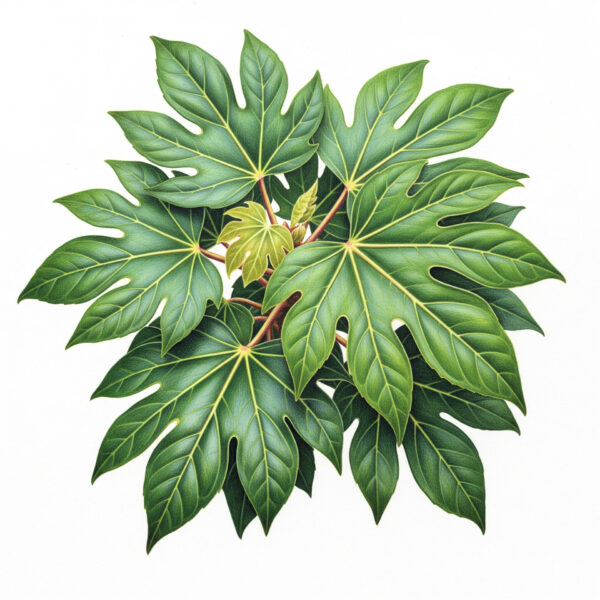Key Characteristics:
- Foliage: The most notable feature is its large, glossy, deep green, palmate leaves, which have a tropical or exotic feel. The leaves are deeply lobed and can be quite large, up to 45 cm across.
- Flowers: In autumn, typically from August to October, it produces spherical clusters of small, creamy-white flowers on branching stems. These flowers are a good source of nectar and pollen for pollinating insects.
- Fruit: Following the flowers, the plant develops small, round, black fruits, which are an attractive food source for birds in the winter.
Growth and Cultivation:
- Hardiness: Fatsia japonica is an evergreen shrub with excellent hardiness, making it suitable for most parts of the UK. It is generally hardy down to -10°C, and will often recover even if it suffers from frost damage. However, cold, drying winds can tear its large leaves in winter, so a sheltered position is best.
- Position: It grows best in partial or full shade, and is an excellent choice for a shady corner or under trees where other plants might struggle. While it can tolerate some sun, it performs better when protected from intense afternoon heat, which can scorch the leaves.
- Soil: It is not fussy about soil and will grow in most types, provided they are moist but well-drained. It appreciates humus-rich, slightly acidic soil.
- Size: It typically grows to a height and spread of 2.5-4 meters.
- Care: This is a low-maintenance plant. It requires regular watering, especially during dry spells, but dislikes waterlogged conditions. Light pruning in mid-to-late spring can help maintain its shape.
Cultivars:While the standard Fatsia japonica is the most common, variegated forms are also available, such as ‘Fatsia japonica ‘Spiders Web” and ‘Fatsia japonica ‘Variegata”, which have leaves speckled or margined with white or cream. These variegated forms may be slightly less hardy and may require more light to bring out their colours.
Uses in the Garden:
- Architectural Feature: Its bold shape and large leaves make it a fantastic architectural plant.
- Exotic or Tropical Gardens: It’s a key plant for creating a jungle-like or tropical feel, often paired with other shade lovers like ferns and bamboos.
- Shady Areas: It is a go-to choice for filling difficult, shaded spots in the garden.
- Containers: It can also be grown in large decorative pots on a patio.

